Swimming Flies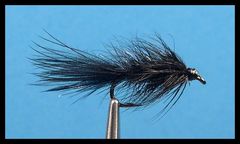 Mini-BuggerIf you're a warmwater angler that likes to fish for trout almost as much as you do for panfish and bass, then you need to have several of these little guys in your fly box. Materials List
Tying NotesEvery angler recognizes the fish taking ability of the Woolly Bugger. The Mini-Bugger - less than one inch long - is the smallest of the Woolly Buggers and, at times, it can be the most effective Bugger in your tackle bag. 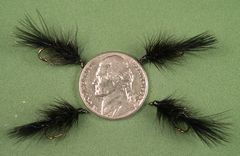 I tie the Mini-Bugger in two sizes - size 12 and size 14. The fly in the tutorial is tied on a size 12 hook. In order to tie this little guy effectively, you need some special materials. First, the tail is made from a black Mini-Marabou blood feather. Mini-Marabou is ideal for tails on small streamers and nymphs. You can dub the body with any fur dubbing, but Hare-Tron Dubbin is the best. It's a blend of rabbit fur and clear antron. When you brush the fly in the final step, the Hare-Tron marries the body hackle, which gives the Mini-Bugger a very buggy look. Finally, you need a couple of hen neck feathers to palmer over the Hare-Tron body. You might be able to substitue a long saddle hackle, but hen neck feathers are much softer and they have more web than most saddle feathers. Make hen neck feathers a prioity. You won't be sorry. Angling TipsThe first Mini-Bugger I remember was several years ago in a fly bin at The Blue Ribbon Fly Shop in Mountain Home, Arkansas. I was told that it was one of the local favorites for tailwater trout on the White and Norfork Rivers. I bought some and had success with them. As I recall, the shop tied their Mini-Buggers on a size 14 dry fly hook. When I returned home, using one of the store bought flies as a sample, I tied up a bunch. I decided to use a 1XL wet fly/nymph hook - the Mustad 3906B - and have continued to use it ever since. 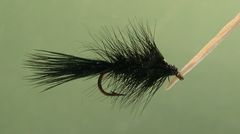
Mini-Bugger under water Recently I picked up a promotional flier put out by Wisconson angler and author, Rich Osthoff, who described his own version of the Mini-Bugger and how he fishes it. Rich is well known for his Soft-Hackle Woolly Worm, having authored several magazine articles describing its merits. Rich says that his Soft-Hackle Mini-Bugger is his top small-stream streamer by a runaway margin. He also says that it is his stock fly for big bluegills and a great 'crossover' fly for picking up bass when targeting panfish. I agree! If you're fishing the Mini-Bugger for trout, bass, or bluegills in moving water you can fish it on a dead drift or strip it. Rich says that it performs upstream, across, or down and the webby profile is visible to fish from any angle. When I fish it for big bluegills in my local ponds and lakes, I fish it with a strip-strip-pause retrieve in and along structure.  I also fasten the fly to my leader with a Duncan or other fixed-loop knot to give it as much action as possible. If you don't know how to tie fixed-loop knots, check out the Warmwater Knots page. Tying Instructions Step 1 Clamp the hook in the vice and crimp the barb. Attach the thread slightly behind the hook's eye and lay down a base of thread back to the hook's bend. 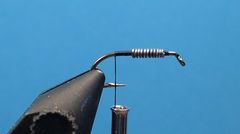 Step 2 Wrap ten wraps of lead wire on the hook's shank. 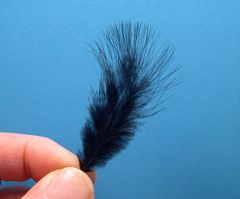 Step 3 Select a Mini-Marabou blood feather for the tail. 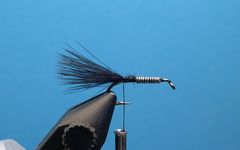 Step 4 Measure the feather against the hook. Tie in the tip of the feather so that the tail is the same length as the hook. 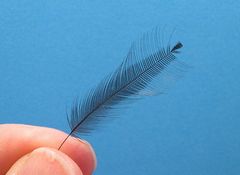 Step 5 Select an appropriately sized hen neck feather and prepare it as shown. The feather's barbs should be the same distance from the hook's shank as the hook's point is when the feather is tied in. 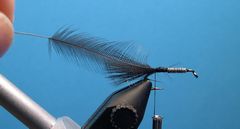 Step 6 Tie in the feather at the base of the tail by it's tip with the cupped side of the feather facing the hook. 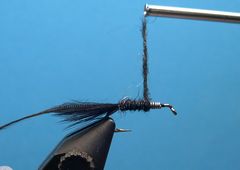 Step 7 Apply a thin noodle of dubbing to the thread and dub the body to slightly past the half-way point on the hook's shank. 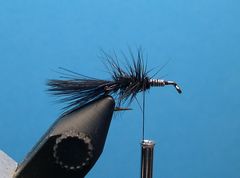 Step 8 Wrap the hackle forward to the dubbing break, bind down the feather, and remove the excess. 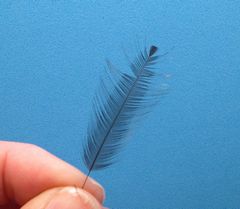 Step 9 Select and prepare a second feather the same way that you prepared the first feather except this feather should have barbs that are slightly longer than the barbs on the first feather. 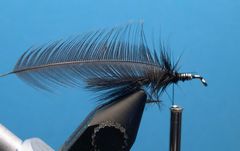 Step 10 Tie in this feather at the dubbing break, tip first, with the cupped side facing the hook. 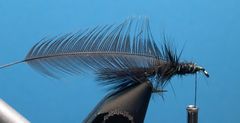 Step 11 Dub the rest of the body with dubbing just as you did the first part of the body in Step 7. Leave enough room for a thread head. 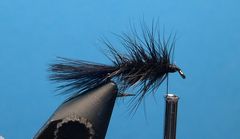 Palmer the feather forward and tie it off at the front of the fly. Remove any excess feather. 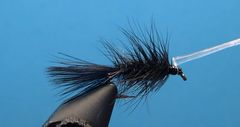 Step 13 Form a neat thread head and tie off the thread with a couple of half-hitches or a whip finish. Coat the thread head with head cement. I prefer Sally Hansen's Hard As Nails nail polish for this task. 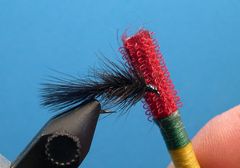 Step 14 After the head cement is dry, vigorously brush the fly with a dubbing brush to marry the hackle fibers with the dubbing. This effort gives the fly a buggier look. If you want to make a dubbing brush click on the "At The Bench." 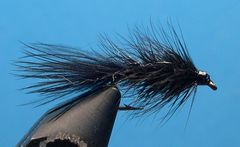 Step 15 Your Mini-Bugger is finished. Tie up a few more and use them for both trout and panfish.
Warmwater Fly Tyer - by Ward Bean
© Copyright 2025 Ward Bean, Council Bluffs, IA, All rights reserved. © Copyright 2025 Ward Bean, Council Bluffs, IA, All rights reserved.
|